How to grow petunia seedlings from seeds at home: rules for care and cultivation
Obviously, you are interested in the correct cultivation of petunia seedlings at home.
Let's say that you already sowed seeds petunias in seedling containers and wait for shoots. Or you have already waited and now you want to know how to care for petunia seedlings after germination and before planting in pots or soil. It means that you have come to the right place, and this material is for you.
By the way! If you only are preparing or are going to sow petunias for seedlings, you will find it useful to read this article.
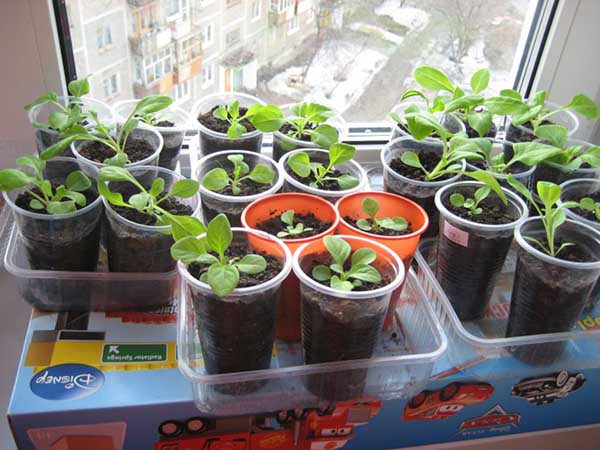
Content
Rules and dates for planting petunias for seedlings
Note! If you still did not plant petunia for seedlings, then choosing the optimal time (s) for planting will help you - this material, and sow the seeds correctly - this article.
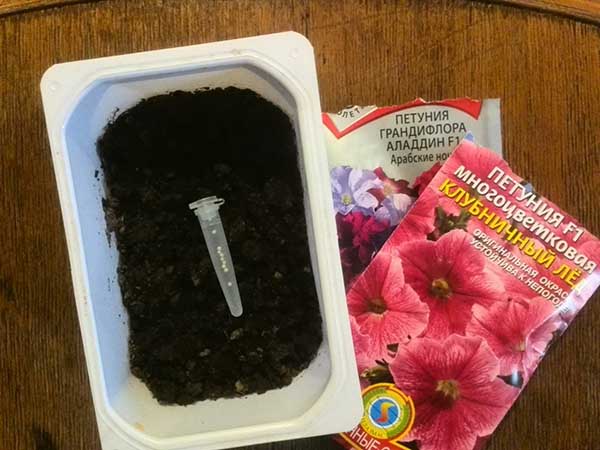
How to care for petunia seedlings after germination at home
And yet, we hope that you came to our article precisely for the sake of this paragraph, from which you will learn all the features of caring for petunia seedlings from germination to planting seedlings in open ground (on a flower bed) or in pots.
The nuances of care before seed germination
So the seeds have been planted. The container with the crops is removed to a warm place where the optimum temperature for germination of petunia seeds is kept - +25 degrees or even higher (up to +30 degrees). Moreover, it is important that the temperature is constant, without fluctuations.
The lower the temperature, the longer you will have to wait for seedlings, the higher - the faster.
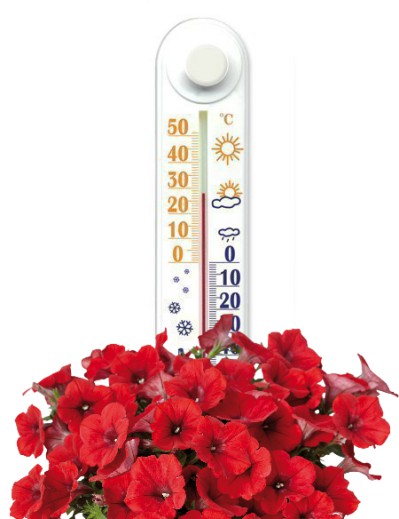
Before the direct germination of seeds and the emergence of seedlings, you will need to monitor the soil moisture in your greenhouse: open the lid daily or remove the film for airing - once a day for 5-10 minutes, so that strong condensation does not form inside.
The fact is that large drops of condensate can fall on non-germinated seeds and wash them off or damage young seedlings, and in petunias they are very delicate.
Leaving immediately after germination
Petunia shoots usually appear in 5-10 days (maximum - after 14 days).
As soon as you see small sprouts (and it is advisable to wait until all or most of the seeds sprout), the lid or film can be removed for a longer time, and it will also be necessary to urgently rearrange the container with the seedlings on a sunny windowsill or under phytolamps.
If you are late, the seedlings will inevitably stretch out in the absence of light.
And after the cotyledon leaves unfold, the cover (shelter) can be completely removed.
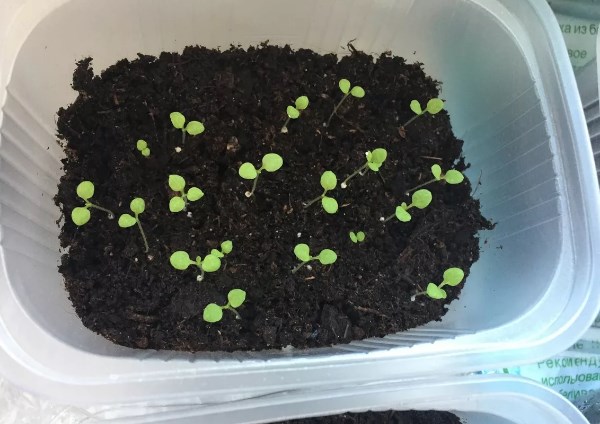
Now you will need monitor soil moisture even more closelysince after removing the cover, the soil will dry out much faster.
Temperature and light conditions
For the normal development of petunia seedlings, a lot of sunlight is required, because the plant is very light-requiring.
Optimal daylight hours for petunia - 14-16 hours a day.
Therefore, even in March (especially in February), you most likely you will have to use special lamps for additional illumination of seedlingssince daylight hours at this time barely exceed 10-11 hours.
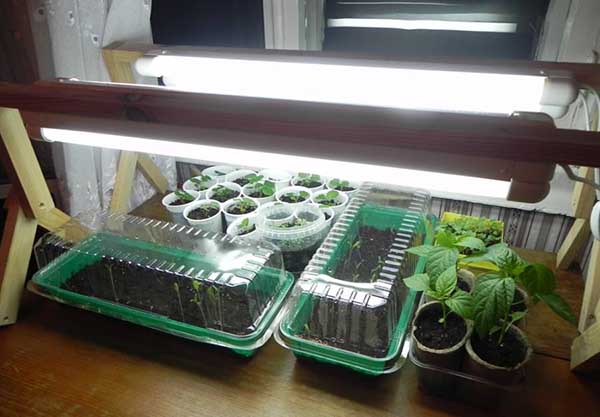
Advice! For example, you can highlight petunia seedlings from 7 am to 9 pm (2 pm) or from 6 am to 10 pm (4 pm).
If you have there is no way to supplement the seedlingsthen it is recommended:
- necessarily put the planting containers on the lightest window sill - southern, or at least southeastern, or southwestern;
- lower the temperature to +18 .. + 20 degreesso that the seedlings do not stretch out.
However! Watch the temperature on the windowsill, it should not fall below +14 .. + 16 degrees!
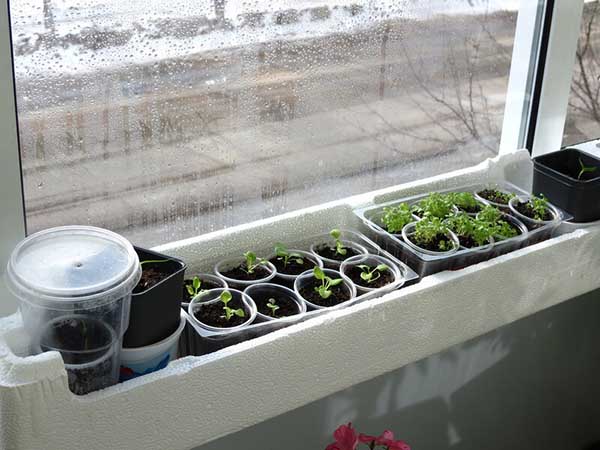
But in general, optimum temperature for growing petunia seedlings after germination and before picking - +20 .. +22 degrees (at 14-16 hour daylight hours), after the pick can be further reduced - up to +16 .. + 20 degrees.
Watering and humidity
The most important thing when growing petunia seedlings, especially at the initial stage, is carefully control substrate moisture and moisturize it as needed (after the top layer has dried).
It is worth understanding! When the plants are still very small, they have superficial roots, they do not need any abundant watering - it is enough to saturate the topsoil with moisture by 3-5 mm.
In this case, watering itself should be carried out as carefully as possible, trying not to erode the soil, because after germination, small petunias are very fragile and can easily be damaged during watering.
therefore not worth use for watering young plants spray, otherwise you will simply wash or knock down the fragile seedlings.
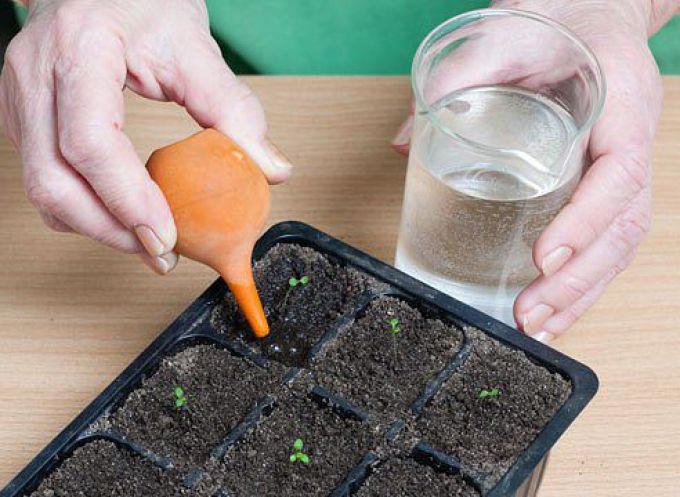
Young seedlings are veryconvenient to water viasyringe or syringe.
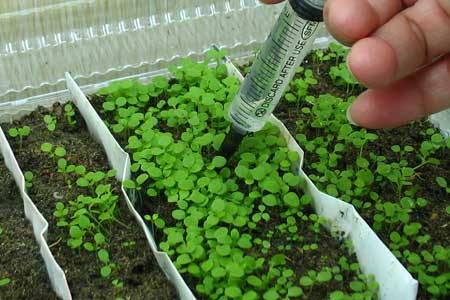
Note! In no case waterlogging of the soil must not be allowed, otherwise it can lead to defeat young seedlings of petunia black leg.
In the future, when the seedlings grow up, it will be much easier to water, but more often, because the green mass (number of leaves) will increase and, accordingly, the plants will consume more moisture. And then you will need to evenly moisten the entire earthen lump.
The first pick of seedlings
When 2-4 true leaves are formed in the seedlings, the procedure for picking (transplanting) it into larger containers should be carried out in order to enable the root system to develop better (it should gradually master ever larger feeding areas).
All the information you need about you will find a pick of petunia seedlings in this article!
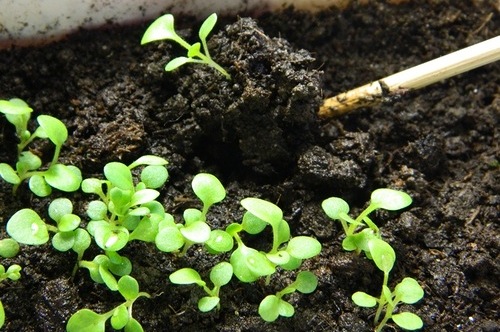
Top dressing
Timely feeding will help petunia seedlings grow more actively and gain green mass.
By the way! The site already has detailed material about when and how to feed petunia seedlings for active growth.
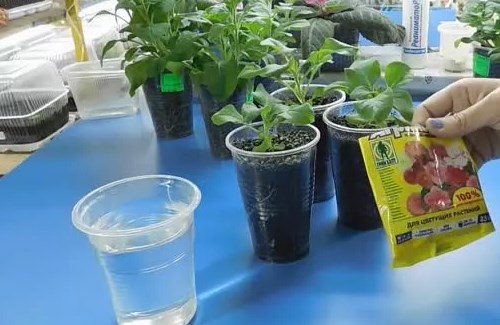
Pinching (shaping)
Many gardeners of the old school believe that without the formation (pinching) of seedlings, it will not be possible to grow a beautiful and luxuriantly flowering bush. They recommend pinching its top (central shoot) when the seedlings have 4 pairs (8 pieces) of leaves.
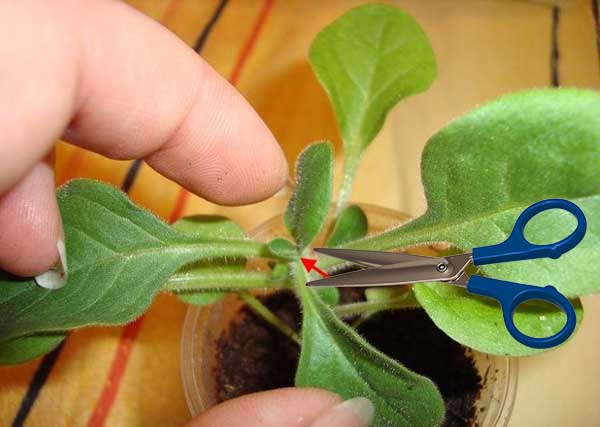
However, most modern varieties of ampel petunias no longer require any formation and pinching.
Another thing is bush petunias, so they are most often pinched.
Also, pinching is carried out in the following cases:
- If the seedlings are stretched out (due to lack of lighting).
- If the apical shoot unexpectedly ends with a seed box (bud), while not giving any axillary (lateral) shoots.
- To propagate petunia by cuttings.
Advice! Immediately after pinching, it is very desirable to apply a foliar or root top dressing with complex fertilizer.
Video: pinching petunia
Second transfer (transshipment)
When petunia seedlings have 3-4 pairs (6-8 pieces) of real leaves, it can be transplanted into larger containers, for example, in 0.5-1 liter cups or pots.
The transfer is carried out by the transshipment method:
- It is necessary to extract the plant along with an earthen lump (just as you can assess the quality of its root system, namely, the roots should occupy the entire volume of the pot).
- In a new, more voluminous container, a depression is made in the size of an earthen coma, into which the seedlings are rolled, and then pressed and compacted from the sides.
- At the end, abundant watering is performed.
Note! Very often, many gardeners dive petunias into 400-500 ml cups and no longer transplant them, immediately placing them in the soil on a flower bed.
Problems of growing petunia seedlings: answers to popular questions
As you probably noticed, the seeds of petunias are very small, respectively, and the seedlings are small and thin at first.
- Why are the seedlings pulled out?
She lacks light. In March and even more so in February, petunia seedlings need to be supplemented. Alternatively, you can compensate for the lack of light by lowering the temperature.
- Is it possible to add soil if the seedlings are stretched out?
- If the seedlings are very thin and elongated, but there is no way to highlight them, can you somehow help them, for example, feed them?
Unfortunately, no additional feeding will help in this case. If there is not enough light, then you can only lower the temperature, but you will hardly be able to fully compensate for the lack of lighting. Plant later next time when daylight hours are longer or purchase phytolamps.
"Excess fertilizers cannot be replaceddisadvantage knowledge ".
- Shoots appeared quickly enough, but then the seedlings began to wither and die ... What is happening?
Chances are, you are not following optimal growing conditions. Your temperature is too high, but the daylight hours are short. That is why, after the greenhouse conditions, which were necessary during the germination of seeds, but are no longer required after germination and the formation of cotyledonous leaves - the young seedlings, at least, begin to stretch out, their root system does not develop and the plant begins to die.
- Some midges began to appear in the seedling containers. What to do, do I need to get rid of them?
As a rule, the appearance of midges is a consequence of waterlogging of the soil. However, the danger is not the midges, but their larvae. In any case, you need to treat the plants and soil with some kind of insecticide - a drug against pests.
- The seedlings are already forming buds, although there is still about a month before planting in open ground (on a flower bed). What to do, can the buds be cut off?
Here you can only give advice for the future - do not sow so early. Now you can only try to slow down the development of seedlings by lowering the temperature (at least +10 degrees), for example, by transferring containers to a loggia or a glazed balcony. But it is not recommended to cut off the buds.
- The seedlings have turned yellow or white leaves, what should I do?
Most likely it ischlorosis, the cause of which is an insufficient amount of iron for active growth, which means that foliar feeding on the leaves with iron chelate or Ferovit preparation must be performed).
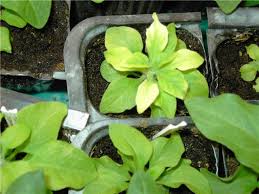
The most dangerous fungal diseasethat your seedlings can pick up is blacklegcaused by high humidity and low temperatures.
For the prevention of blackleg and other fungal diseases it is recommended to periodically spill your seedlings with a solution Fitosporin.
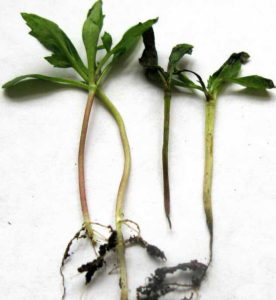
When to plant petunia seedlings in open ground or in pots (pots)
When the seedlings grow up and get stronger enough, and after the threat of recurrent frosts has passed, it will be possible to start planting petunias in a flower bed or in pots (pots). However, before that, it is necessary to harden it (seedlings) in order to initially adapt the plants to more severe outdoor conditions.
Note! About when to plant seedlings and how to further care for petunia will be described in detail in the following materials on the site.
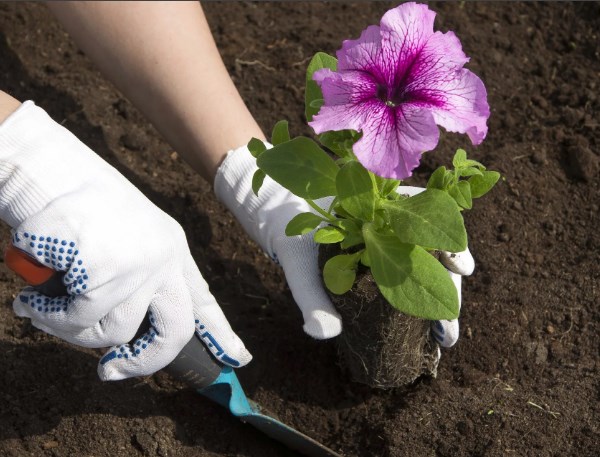
What do you think about growing petunia seedlings now? Not so difficult, is it? The more beautiful the flowers, the more care and maintenance they require, including during the seedling period. How do you want ...
Video: growing petunias without mistakes - lesson 2 and 3 from the company "Biotekhnika"


Typically, petunia seeds emerge in 5-10 days, but they can germinate in 14 days. The germination rate is influenced by humidity and temperature. Accordingly, the reasons may be insufficient humidity, too low or, on the contrary, high temperature (below +20 or above +30 degrees, optimally +25). However, you may have come across poor quality or stale seeds.
Condensation is formed due to temperature differences (night and day), respectively, you will almost be able to get rid of condensation completely. It is important that this difference is not too large.
You can do only one thing here - thin out the seedlings, in other words, remove some of the seedlings.